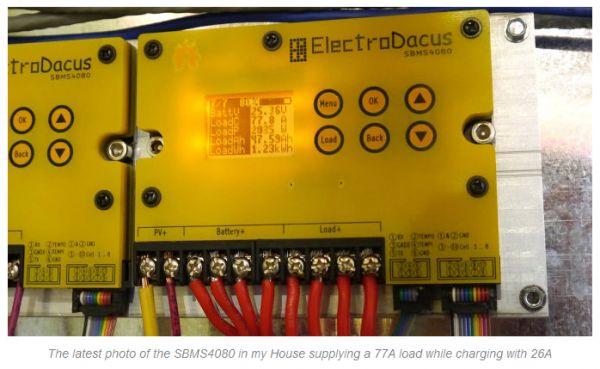Solar BMS (Solar Battery Management System)
is a solar charge controller designed to replace the Lead Acid solar charge controllers most people use today in Offgrid, RV, Boats and multiple other applications with 12V and 24V systems.
Solar BMS can be used with 3 up to 8 Lithium cells (any type) or supercapacitors.
The new SBMS100 will have multiple improvements over the first generation SBMS4080 see further for details.
Lithium and in particular LiFePO4 is a better long term investment than Lead Acid batteries.

–LiFePO4 has 2000 to 8000 cycles (70% to 100% DOD) vs Lead Acid 250 to 1200 cycles (20% to 50% DOD).
(This means you can get LiFePO4 with half the Lead Acid capacity since LiFePO4 can be discharged deeper and does not have to be fully charged as Lead Acid).
–LiFePO4 has a charge / discharge efficiency of 95 to 98% vs Lead Acid just 50 to 75%.
–LiFePO4 will cost about the same as 2x capacity Lead Acid.
(A half capacity LiFePO4 will perform the same or better do to ability to discharge deeper and stay discharged with no effect on life cycle and do to better charge / discharge efficiency)
–LiFePO4 protected with Solar BMS can last 20 to 30 years where a typical Lead Acid will only last 4 to 6 years.
–LiFePO4 can be 5 to 10x better value than Lead Acid over the life of the battery
–The cost benefit are not the only benefits.
– LiFePO4 can be installed indoors with no need for external venting since it does not produce flammable Hydrogen gas as Lead Acid.
– LiFePO4 even at the same capacity as Lead Acid is much smaller and lighter (in some applications this can be important).
– LiFePO4 is maintenance free (AGM also claims that but in solar applications you probably need an expensive (1 Litre/kWh) gasoline or diesel generator to recharge the battery if there are more than two consecutive cloudy days else the battery life will be drastically affected).
Some Links in support to my claims:
Here is a similar Solar BMS from Sony using LiFePO4 (Lithium Iron Phosphate) battery to store solar energy but designed for grid tied systems – Link and a more detailed document here Link
Bosch has a similar grid tied solar storage system see Link using Lithium Iron Phosphate with a 7000cycles and 25years life claim.
For Batteries you can check the Winston specifications for their Lithium Iron Phosphate batteries Link There are other manufacturers of Lithium Iron Phosphate personally I use GBS cells since they where available about 3 years ago locally and where the best option for me at that time. But Winston and others seems to have better specs. My battery has already two years of full time offgrid with daily deep discharge and there is no measurable degradation see my house power consumption graphs below for more details.
1) Double the power
The SBMS100 can handle a total of 6kW (3kW PV array and 3kW Load) where SBMS4080 is able to do 3kW (1kW PV array and 2kW Load).
In order to make this happen a few changes are necessary:
a) Larger power connectors that can take 35mm2 (#2 AWG) cables to handle 120A limit on the SBMS100
b) Thicker copper traces on the metal core PCB.
c) Higher power mosfets and more of them to handle the increased power and dual PV inputs.
d) Ideal diodes for the dual PV input.
(ideal diodes are made of a power mosfet and an ideal diode controller. A normal Schottky diode will dissipate to much heat at this current level that is why ideal diodes are the only option).
2) 24bit ADC for increased current, power and energy measurement accuracy.
The SBMS4080 uses the internal 14bit ADC of the ISL94203 for current measurement. While this was a cost effective method it did not offer great resolution at just 100mA and because this was also used for HW over-current protection there where some aliasing issues that needed SW filters.
The new SBMS will use a 24bit ADC from Linear Technology with multiple differential inputs to measure current on Battery and the two PV inputs with increased resolution (one or two orders of magnitude better).
Some of this 24bit ADC inputs will also be available to user on the 26pin connector for measurement of external sensors and possible automations or future add-ons for the SBMS100.
This will require:
a) The 24bit ADC IC and multiple current sense amplifiers 3 for SBMS100 instead of 1 on the SBMS4080.
b) A 4 layer main PCB do to increase in complexity over 2.5x more parts that on the SBMS4080.
3) Higher resolution and size LCD
As those that have the SBMS4080 know the small 1.4″ Nokia LCD is not that great with his limited 84×48 B&W resolution.
On the new SBMS100 a 2.2″ Color LCD with 320×240 pixels will be used.
The new LCD will offer much more space for displaying data and maybe even some energy graphs (not sure I will have time to implement graphs at release time but will sure be an option in later firmware updates).
For more detail: 120A Solar BMS charger LiFePO4,Li-ion OffGrid,RV with WiFi
